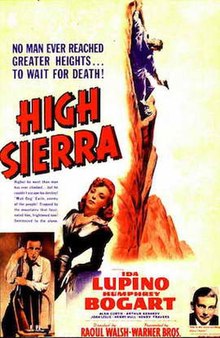High Sierra, Raoul Walsh’s extremely well directed and well acted 1941 film noir is co-scripted by W.R. Burnett and John Huston, based on Burnett’s novel.
Grade: B+ (**** out of *****)
| High Sierra | |
|---|---|

Theatrical release poster
|
|
Featuring Ida Lupino, who got star billing, and Humphrey Bogart in a career-making part, the movie was shot on location at Whitney Portal, close to Mount Whitney.
Both George Raft and Paul Muni had earlier turned down the part that would make Bogart a major bankable star. In the same year, 1941, Bogart also starred in Huston’s striking feature debut, the classic mystery noir, The Maltese Falcon. Bogart would cement his star position, after playing Rick in the 1943 Oscar-winning movie, Casablanca.
The screenplay, co-written by John Huston, was adapted from the novel by William R. Burnett (known for the early gangster films, such as “Little Caesar” and “Scarface”).
The film’s extensive location shooting is impressive, especially the climactic scenes, when the police pursue Bogart’s gangster “Mad Dog” Roy Earle from Lone Pine up to the foot of the mountain.
In the first scene, Big Mac (Donald MacBride), an older gangster planning a robbery of a California resort casino, wishes to recruit Roy Earle (Humphrey Bogart), to lead the heist. Roy has just been released from prison by pardon,
Driving across the country to a mountainous camp, Roy meets the three men who would work with him. Louis Mendoza (Cornel Wilde), who is working in the resort, Red (Arthur Kennedy), and Babe (Alan Curtis).
Babe has also brought along Marie (Ida Lupino), whom Roy wants to send back to Los Angeles. However, after tough arguments, Marie convinces Roy to let her stay, and she adopts a dog called Pard.
Predictably, Marie falls in love with Roy as he plans and executes the robbery, but he does not reciprocate. On the drive up to the mountains,
Meanwhile, Roy meets the family of Velma (Joan Leslie), a young, impressionable woman with a deformed foot, and he decides to pay for corrective surgery. While she is convalescing, Roy asks Velma to marry him, but she refuses; it turns out she’s engaged to another man back home.
When Velma’s fiancé arrives, Roy turns to Marie, and they become lovers, planning to be engaged.
Predictably, the heist goes wrong when they are interrupted by a security guard. Mendoza, Red and Babe get involved in a car accident, and while Red and Babe lose their lives, Mendoza talks to the police.
After Roy and Marie leave town, a dragnet is put out for him. The two separate, allowing Marie time to escape, while Roy is pursued until he climbs one of the Sierra mountains, where he holes up. Unfazed, Roy challenges the police: “Come and get me.”
The ending is both grim and ironic: After trading shots with the police, he hears Pard barking. Running out while calling Marie’s name, Roy is shot dead in the back by a sharpshooter.
Scholars have struggled with the issue of how label High Sierra in terms of genre. Is it a crime-gangster? Is it a film noir? Is it a star vehicle? No matter, it’s a great film, which moves with energy, speed, and excitement, all qualities which define Walsh’s best films (my favorite Walsh picture is White Heat of 1949).
The construction of Bogart’s character, which is more complex and multi-nuanced than the norm, and the effortless, hard-boiled quality of his acting, elevate the whole film beyond the realm of yet another crime melodrama.
The central figure is complex, a ruthless mobster (who used to be a farm boy), a gunman who had killed in cold blood, But he could also be kind to his mongrel doll, and sensitive to the needs of the two women, Lupino’s taxi dancer who become his moll, and Leslie’s crippled girl.
Recycling:
The film was remade twice. First, in 1949, also by Raoul Walsh, as a western, “Colorado Territory,” starring Joel McCrea and Virginia Mayo. Then, in 1955, as “I Died a Thousand Times,” starring Jack Palance and Shelley Winters, and directed by Stuart Heisler.
It was also adapted as a radio play, in 1942, with Bogart and Claire Trevor, and in 1944, with Bogart and Ida Lupino.
Cast
Ida Lupino as Marie
Humphrey Bogart as Roy Earle
Alan Curtis as Babe
Arthur Kennedy as Red
Joan Leslie as Velma
Henry Hull as Doc Banton
Henry Travers as Pa
Jerome Cowan as Healy
Credits:
Directed by Raoul Walsh
Produced by Mark Hellinger
Screenplay by John Huston, W.R. Burnett, based on “High Sierra” the 1940 novel by W.R. Burnett
Music by Adolph Deutsch
Cinematography Tony Gaudio
Edited by Jack Killifer
Distributed by Warner Bros.
Release date: January 21, 1941
Running time: 100 minutes
Budget $491,000
Box office $1,489,000



